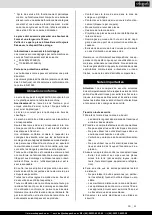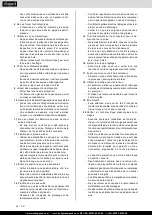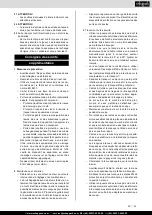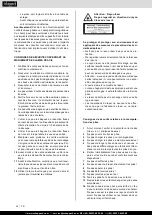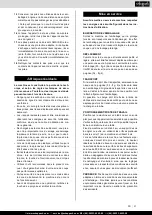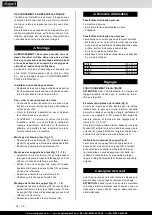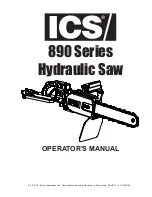
www.scheppach.com
+(49)-08223-4002-99
+(49)-08223-4002-58
23
GB
–
Ensure that the rotation speed indicated on the
saw blade is the same as the rotation speed
indicated on the saw.
–
The workpiece must always be clamped at the
saw table.
–
Before each cutting operation make sure that
the machine is safe.
Warning!
This electric tool generates an electro
-
magnetic field during operation. This field can impair
active or passive medical implants under certain
conditions. In order to prevent the risk of serious or
deadly injuries, we recommend that persons with
medical implants consult with their physician and the
manufacturer of the medical implant prior to operat
-
ing the electric tool.
SAFETY INSTRUCTIONS FOR THE HANDLING
OF SAW BLADES
1
Only use insertion tools if you have mastered
their use.
2
Observe the maximum speed. The maximum
speed specified on the insertion tool may not be
exceeded. If specified, observe the speed range.
3
Observe the motor / saw blade direction of rota
-
tion.
4
Do not use any insertion tools with cracks. Sort
out cracked insertion tools. Repairs are not per
-
mitted.
5
Clean grease, oil and water off of the clamping
surfaces.
6
Do not use any loose reducing rings or bushes
for the reducing of holes on saw blades.
7
Make sure that fixed reducer rings for securing
the insertion tool have the same diameter and
have at least 1/3 of the cutting diameter.
8
Make sure that fixed reducer rings are parallel
to each other.
9
Handle insertion tool with caution. They are ide
-
ally stored in the originally package or special
containers. Wear protective gloves in order to im
-
prove grip and to further reduce the risk of injury.
10
Prior to the use of insertion tools, make sure that
all protective devices are properly fastened.
11
Prior to use, make sure that the insertion tool
meets the technical requirements of this electric
tool and is properly fastened.
12
Only use the supplied saw blade for cutting wood,
never for the processing of metals.
Attention: Laser radiation
Do not stare into the beam
Class 2 laser
–
Connect a dust collecting device to the electric
tool when sawing wood. The emission of dust
is influenced, among other things, by the type
of material to be processed, the significance of
local separation (collection or source) and the
correct setting of the hood/guide plates/guides.
–
Do not use saw blades made of high-speed
alloy steel (HSS steel).
2
Maintenance and repair
–
Pull out the mains plug for any adjustment or
repair tasks.
–
The generation of noise is influenced by vari-
ous factors, including the characteristics of saw
blades, condition of saw blade and electric tool.
Use saw blades which were designed for re
-
duced noise development, insofar as possible.
Maintain the electric tool and tool attachments
regularly and if necessary, initiate repairs in
order to reduce noise.
–
Report faults on the electric tool, protective
devices or the tool attachment to the person
responsible for safety as soon as they are dis
-
covered.
3
Safe work
–
Only use saw blades for which the maximum
permissible speed is not lower than the maxi
-
mum spindle speed of table saws and which
are suitable for the material to be cut.
–
Make sure that the saw blade does not touch
the rotary table in any position by pulling out
the mains plug and rotating the saw blade by
hand in the 45° and 90° position. If necessary,
readjust the saw head.
–
When transporting the electric tool, only use
the transport devices. Never use the protective
devices for handling or transport.
–
Make sure that the lower part of the saw blade
is covered during transport, e.g. by the protec
-
tive device.
–
Be sure to only use spacers and spindle rings
specified by the manufacturer as suitable for
the intended purpose.
–
The floor around the machine must be level,
clean and free of loose particles, such as chips
and cutting residues.
–
Do not remove any cutting residues or other parts
of workpieces from the cutting zone while the
machine is running and the saw unit is not at rest.
–
Make sure that the machine is always secured
on a workbench or a table if at all possible.
–
Support long workpieces (e.g. with a roller ta
-
ble) to prevent them sagging at the end of a cut.
–
Make sure you select the appropriate saw blade
for the material you are cutting.
Warning! Never use the saw for cutting material
other than that specified by the manufacturer.
–
Use the saw only when the protective devices
are functional, they are in good condition and
in the proper position.
Summary of Contents for HM80L
Page 185: ...185 ...

























